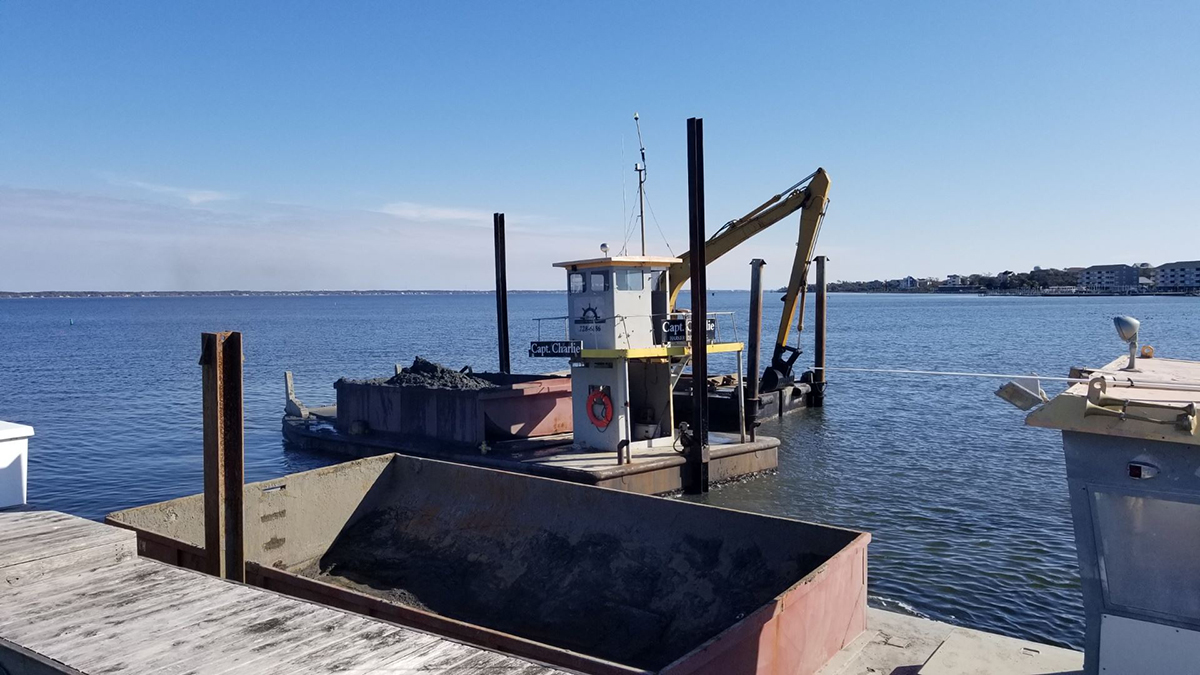
WILMINGTON – Sand and other material from dredging projects funded by marinas, local governments and private property owners will remain forbidden from placement at federally managed disposal sites.
Five years have passed since the Army Corps of Engineers stopped allowing dredged material from nonfederal projects to be placed on the disposal sites it maintains, a policy that will remain effective “for the foreseeable future,” according to Jed Cayton, a public affairs specialist with the Corps’ Wilmington District.
Supporter Spotlight
“Federal placement sites will not be available to non-federal projects based on need,” Cayton said in an email responding to questions. “Currently, (the Corps) is unable to dredge several locations within the Atlantic Intracoastal Waterway as a direct result of the federal placement sites being full and unable to hold additional dredged material.”
The move, which is nationwide, has had local and state government officials scrambling to find alternative disposal sites, which has largely equated to higher project costs because those sites are farther from the areas where dredging occurs.
Thus is the case at Wrightsville Beach Marina, where an average of about 7,500 cubic yards of sand is dredged every three years to maintain a suitable water depth for boats and yachts.
For years, the marina placed material pumped from the area around the property to privately owned spoil islands whose owners granted easements to the Corps.
“We were able to find an area just outside of the easement we’ve been able to use, which is at incredible financial hardship,” said Wrightsville Beach Marina General Manager Sam Clary.
Supporter Spotlight
The marina had to build dikes and a spillway to make the land suitable to hold disposed material, which cost a hefty $100,000.
“In addition to that it’s almost a mile away from us so it costs about 50% more to dredge and pump so far away,” Clary said.
The extra expense falls on the backs of the marina’s customers.
“It’s still in high demand here just because it’s limited space, but it’s coming at a premium and I don’t know how sustainable it is,” Clary said. “We hope that over time that the regulations will be eased. We’re moving beach quality sand. It’s not much. I just think it should be on a case-by-case basis instead of a national mandate.”
Wilmington District officials recently submitted to the North Carolina Department of Environmental Quality a final report identifying and assessing existing nonfederal dredged material disposal placement sites along the Intracoastal Waterway within the state.
The report wraps up the first of two studies co-funded by the state to determine how many nonfederal disposal sites exist, where those sites are, which of those will accept material, generate a 20-year forecast of how much space will be needed in each of the 13 counties along the waterway, and identify the counties with the greatest need and greatest shortfalls.
DEQ Coastal Infrastructure Grant Coordinator Kevin Hart explained to the state Coastal Resources Commission last month that the Corps had identified 26 nonfederal placement sites in seven of the 13 counties. Those counties include Brunswick, Carteret, New Hanover, Onslow, Pamlico, Pender and Tyrell.
Twelve of the sites are state-owned, 13 are privately owned and one is a federally owned facility.
Of the 26, 20 are restricted-use sites, generally meaning that either the property owners of those areas said they will not accept material from other dredge projects or only beach-compatible sand is allowed.
There are 227 different waterfront facilities along the waterway, Hart said.
Carteret and New Hanover counties account for 62% of those marinas.
The Corps identified four nonfederal disposal sites, including two owned by the State Ports Authority in Carteret County. Three of those are restricted-use sites.
Nine sites have been identified in New Hanover County. Two of those are restricted-use sites.
In all, 206 marinas have agreed to provide to the Corps details on how often they dredge and their anticipated needs over the next 20 years.
“At this time, it is unknown whether the current sites can meet the demand,” Hart said in an email a few weeks after the Coastal Resources Commission’s Sept. 15 meeting.
The state is finalizing a cost-share agreement with the Corps for the second phase of the study, which is to examine the dredging needs of marinas that have more than 10 boat slips. The agreement will have to be signed off by the DEQ Secretary Elizabeth Biser before the Corps initiates the study.
“Approximately 70 to 75 non-active placement sites adjacent to the Atlantic Intracoastal Waterway will be identified, which may also be available for placement of dredged material by local communities, marinas, or other waterfront facilities,” Cayton said. “Lastly, the report will outline general environmental requirements or concerns associated with constructing new, or redeveloping existing, dredged material placement sites.”
This phase of the study may take up to a year after a cost-share agreement has been signed, Hart said.
Time may only drive up costs of nonfederal projects forced to truck material to inland disposal sites.
“There’s always a way, it’s just how much money you can afford to spend on it,” Clary said. “You can always put it bucket-to-barge. It may cost a million dollars, we just don’t know. We hope that over time that the regulation will be eased.”







